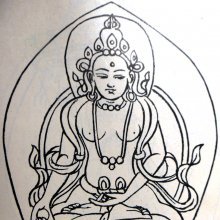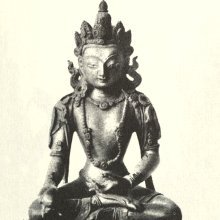Jnanaketu, Jñānaketu: 8 definitions
Introduction:
Jnanaketu means something in Buddhism, Pali, Hinduism, Sanskrit. If you want to know the exact meaning, history, etymology or English translation of this term then check out the descriptions on this page. Add your comment or reference to a book if you want to contribute to this summary article.
Images (photo gallery)
In Buddhism
Mahayana (major branch of Buddhism)
Source: Wisdom Library: LokottaravādaJñānaketu (ज्ञानकेतु) is the name of a Buddha under whom Śākyamuni (or Gautama, ‘the historical Buddha’) acquired merit along the first through nine bhūmis, according to the Mahāvastu. There are in total ten bhūmis representing the ten stages of the Bodhisattva’s path towards enlightenment.
Jñānaketu is but one among the 500 Buddhas enumerated in the Mahāvastu during a conversation between Mahākātyāyana and Mahākāśyapa, both principle disciples of Gautama Buddha. The Mahāvastu is an important text of the Lokottaravāda school of buddhism, dating from the 2nd century BCE.

Mahayana (महायान, mahāyāna) is a major branch of Buddhism focusing on the path of a Bodhisattva (spiritual aspirants/ enlightened beings). Extant literature is vast and primarely composed in the Sanskrit language. There are many sūtras of which some of the earliest are the various Prajñāpāramitā sūtras.
Tibetan Buddhism (Vajrayana or tantric Buddhism)
Source: Wisdom Library: MañjuśrīnāmasaṃgītiJñānaketu (ज्ञानकेतु) is one of the sixteen bodhisattvas appearing in the Vajradhātu-mahāmaṇḍala, according to the Nāmamantrārthāvalokinī v5.38-41. The Nāmamantrārthāvalokinī (literally, ‘an explanation of the nāma-mantras’) is a commentary (ṭīkā) on the 8th century Mañjuśrīnāmasaṃgīti.
Jñānaketu is a name of Mañjuśrī (the embodiement of non-dual knowledge) and, together with other names, forms the core essence of the Mañjuśrīnāmasaṃgīti. The Nāmamantrārthāvalokinī provides the practitioner a sādhana (‘meditative practice’) to turn these names into mantras. These mantras are chanted for the benefit of all beings, and then placed and contemplated in the Vajradhātu-mahāmaṇḍala, which is an extended version of the Vajradhātu-maṇḍala.
Source: archive.org: The Indian Buddhist IconographyJñānaketu (ज्ञानकेतु) is the name of a Bodhisattva commonly depicted in Buddhist Iconography, and mentioned in the 11th-century Niṣpannayogāvalī of Mahāpaṇḍita Abhayākara.—his color is yellow or blue; his symbol is the flag with cintāmaṇi jewel.—Jñānaketu occurs only once in the Chinese collection, where his form is identical with his sire Ratnasambhava.
Jñānaketu is described in the Niṣpannayogāvalī as follows:—
Source: Brill: Śaivism and the Tantric Traditions (tantric Buddhism)(1: Mañjuvajra-maṇḍala):—“Jñānaketu is yellow in colour. He holds in his right hand the flag marked with the Cintāmaṇi jewel. The left hand displays the Varada-mudrā”. (2: Durgatipariśodhana-maṇḍala):—“Jñānaketu is blue in colour. He holds in his right hand the flag marked with the Cintāmaṇi jewel. The clenched left hand rests on the hip”.
Jñānaketu (ज्ञानकेतु) refers to one of the sixteen Bhadrakalpa Bodhisattvas, according to the Niṣpannayogāvalī 44ff and Abhayākaragupta’s Durgatipariśodhana-maṇḍala (Cf. Niṣpannayogāvalī 66ff.).—A set of sixteen Bodhisattvas often supplements the deities of the Tattvasaṃgraha in later Vajradhātu-maṇḍala descriptions. These are generally the sixteen Bodhisattvas of the present aeon (bhadrakalpa) [e.g., Jñānaketu], as described for example in Abhayākaragupta’s Niṣpannayogāvalī Vajradhātu-maṇḍala.—Cf. also Nāmamantrārthāvalokinī and Abhayākaragupta’s forty-three deity Mañjuvajra-maṇḍala (Tricatvāriṃśadātmakamañjuvajra-maṇḍala: see Niṣpannayogāvalī 50)

Tibetan Buddhism includes schools such as Nyingma, Kadampa, Kagyu and Gelug. Their primary canon of literature is divided in two broad categories: The Kangyur, which consists of Buddha’s words, and the Tengyur, which includes commentaries from various sources. Esotericism and tantra techniques (vajrayāna) are collected indepently.
Languages of India and abroad
Sanskrit dictionary
Source: Cologne Digital Sanskrit Dictionaries: Edgerton Buddhist Hybrid Sanskrit DictionaryJñānaketu (ज्ञानकेतु).—(1) name of one or more former Buddhas: Mahāvastu i.137.10; Lalitavistara 171.18; Gaṇḍavyūha 423.2; (2) name of a Bodhi- sattva: Gaṇḍavyūha 3.18; (3) name of a samādhi: Mahāvyutpatti 559; Śatasāhasrikā-prajñāpāramitā 1419.16.
Source: Cologne Digital Sanskrit Dictionaries: Monier-Williams Sanskrit-English DictionaryJñānaketu (ज्ञानकेतु):—[=jñāna-ketu] [from jñāna > jñā] m. ‘having marks of intelligence’, Name of a man, [Lalita-vistara xiii, 156]
[Sanskrit to German]
Sanskrit, also spelled संस्कृतम् (saṃskṛtam), is an ancient language of India commonly seen as the grandmother of the Indo-European language family (even English!). Closely allied with Prakrit and Pali, Sanskrit is more exhaustive in both grammar and terms and has the most extensive collection of literature in the world, greatly surpassing its sister-languages Greek and Latin.
See also (Relevant definitions)
Starts with: Jnanaketudhvaja.
Ends with: Suvilokitajnanaketu, Vairocanapranidhijnanaketu, Vairochanapranidhijnanaketu.
Full-text: Jnanaketudhvaja, Jnanalotu, Bodhisattva.
Relevant text
Search found 2 books and stories containing Jnanaketu, Jñānaketu, Jnana-ketu, Jñāna-ketu; (plurals include: Jnanaketus, Jñānaketus, ketus). You can also click to the full overview containing English textual excerpts. Below are direct links for the most relevant articles:
The Indian Buddhist Iconography (by Benoytosh Bhattachacharyya)
The Mahavastu (great story) (by J. J. Jones)
Chapter XV - The eighth Bhūmi < [Volume I]

